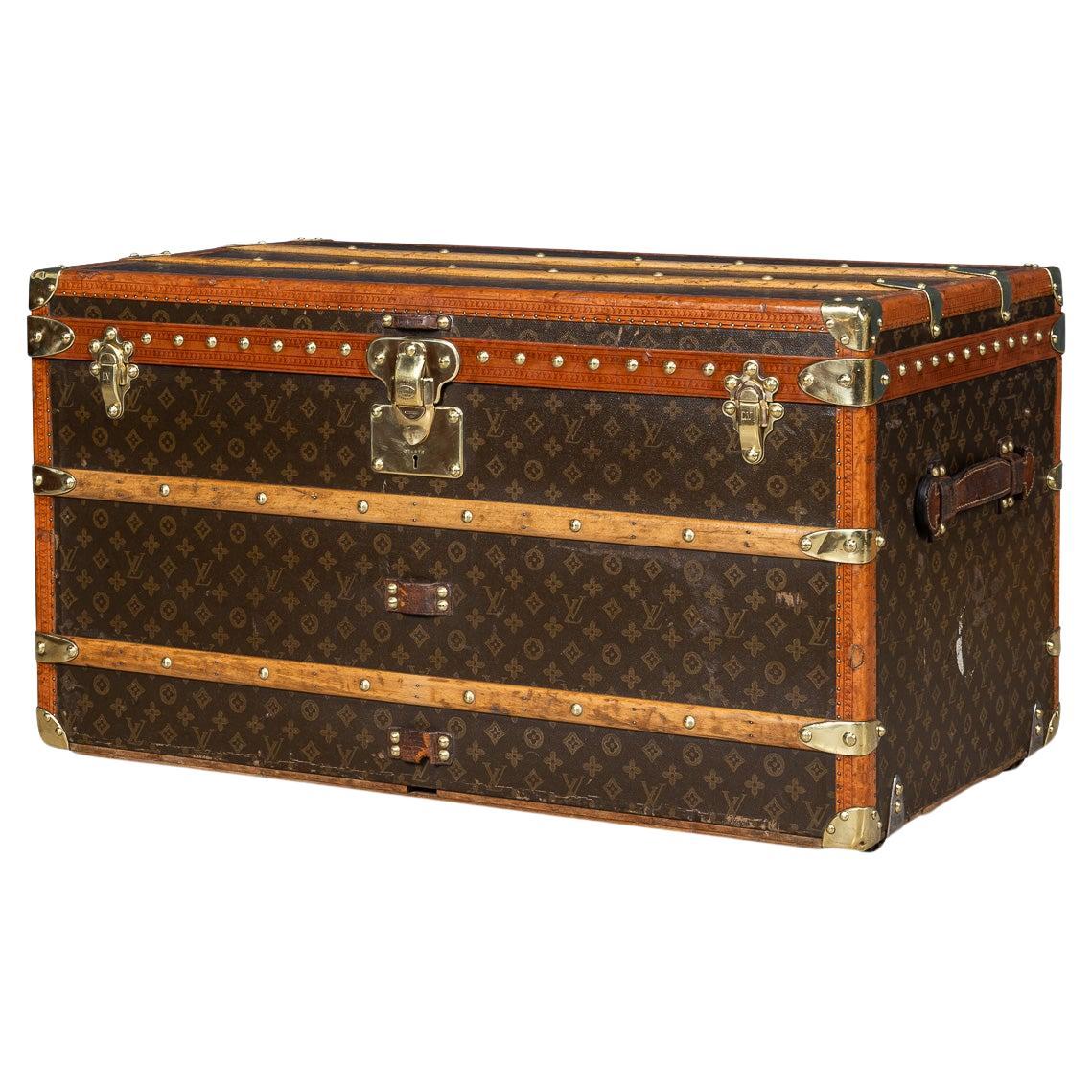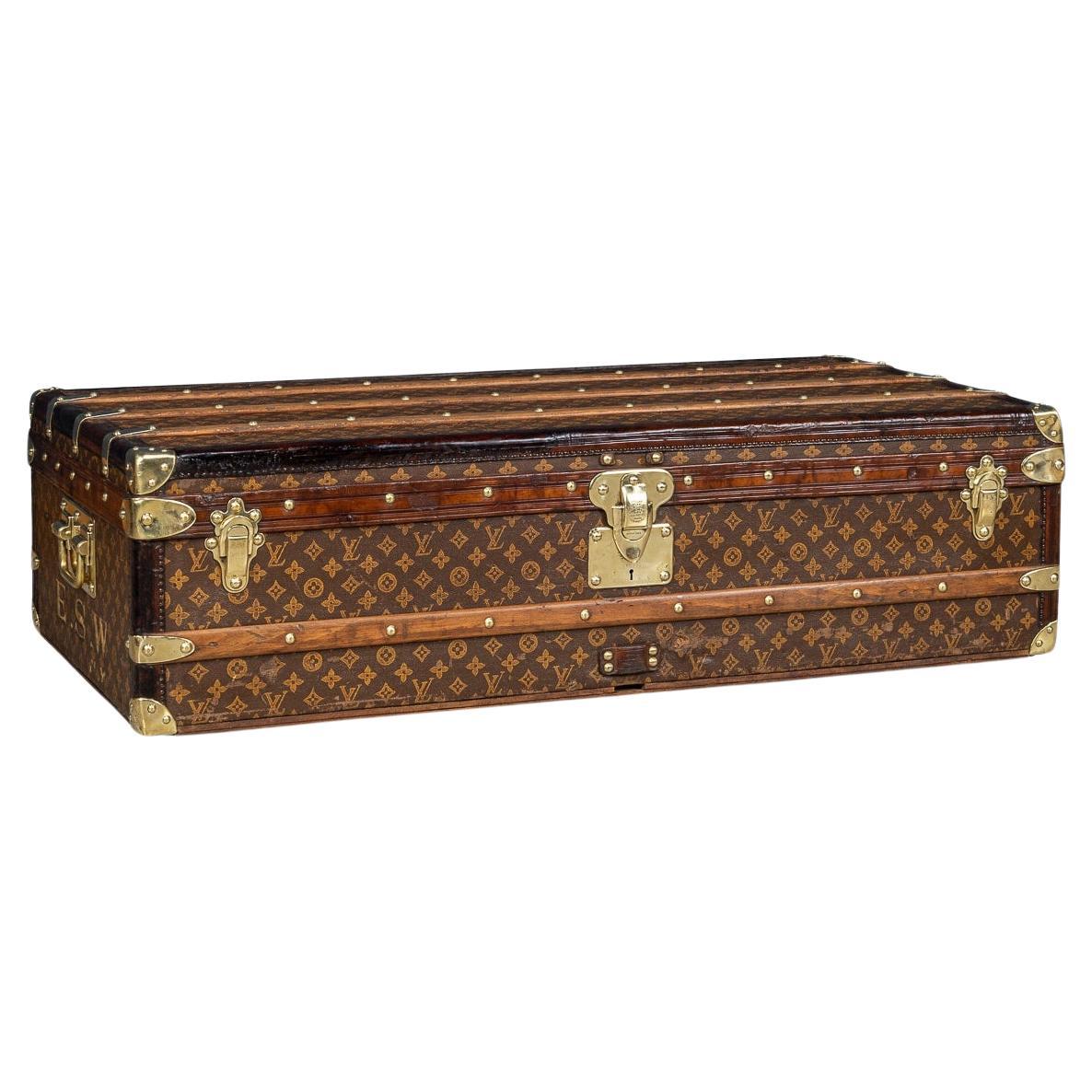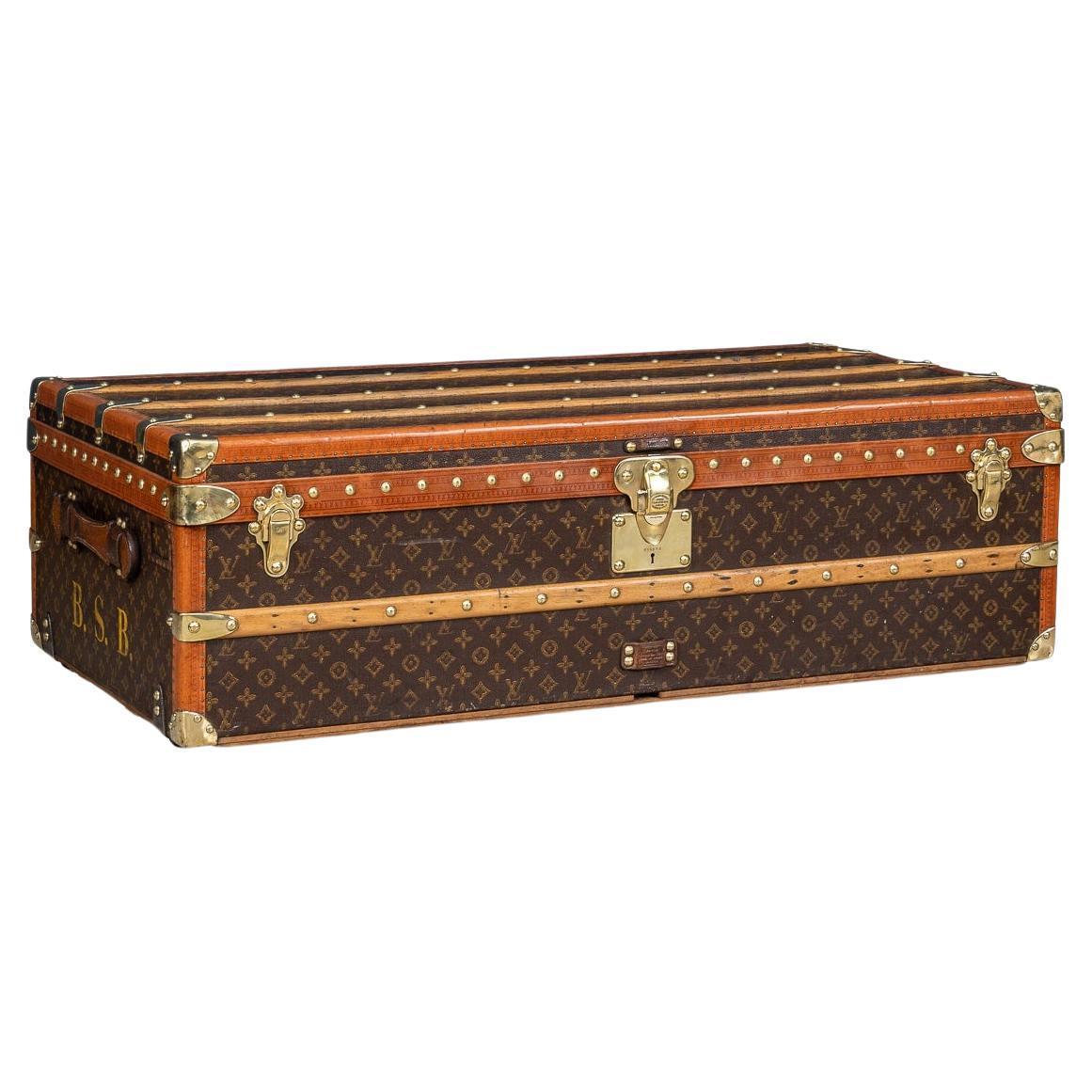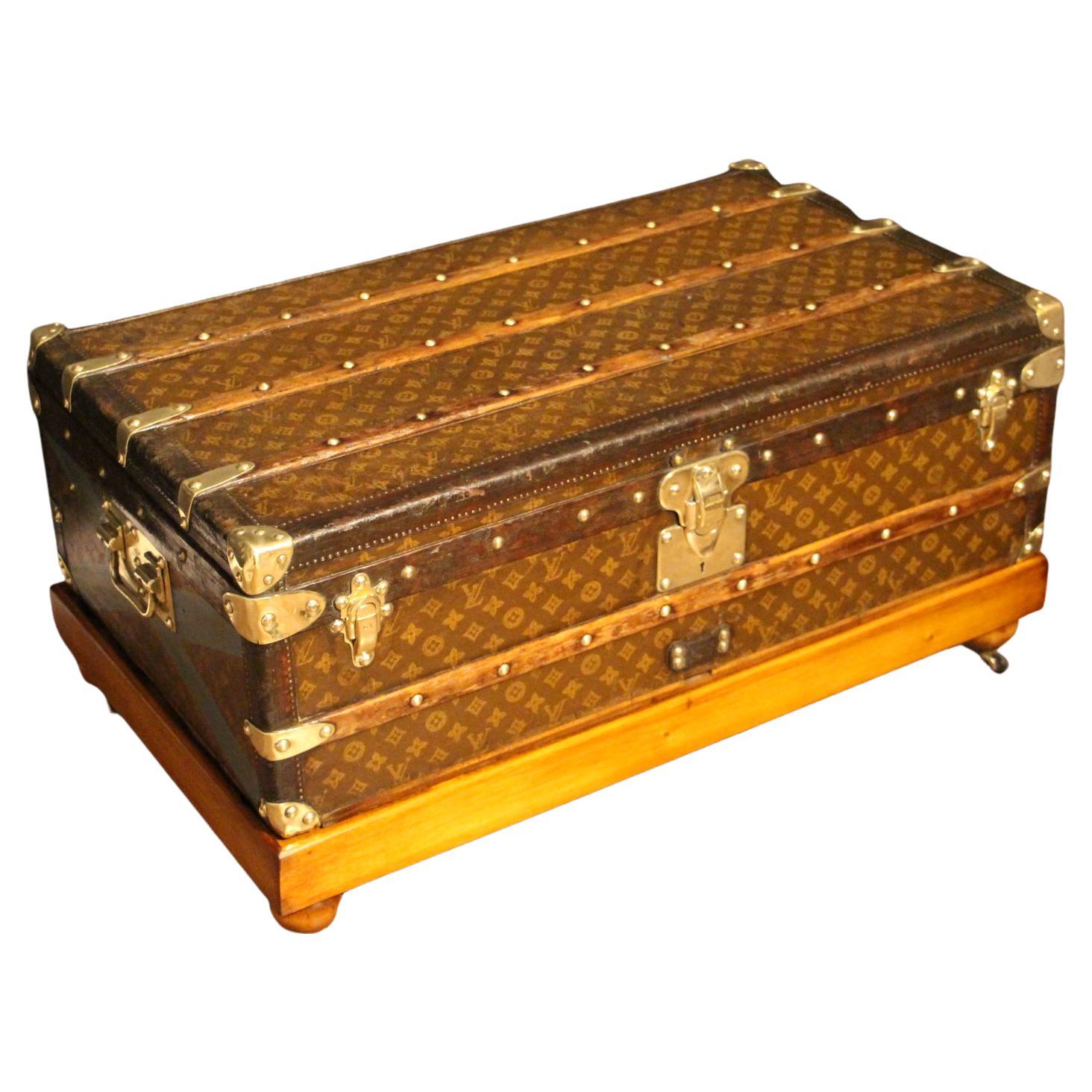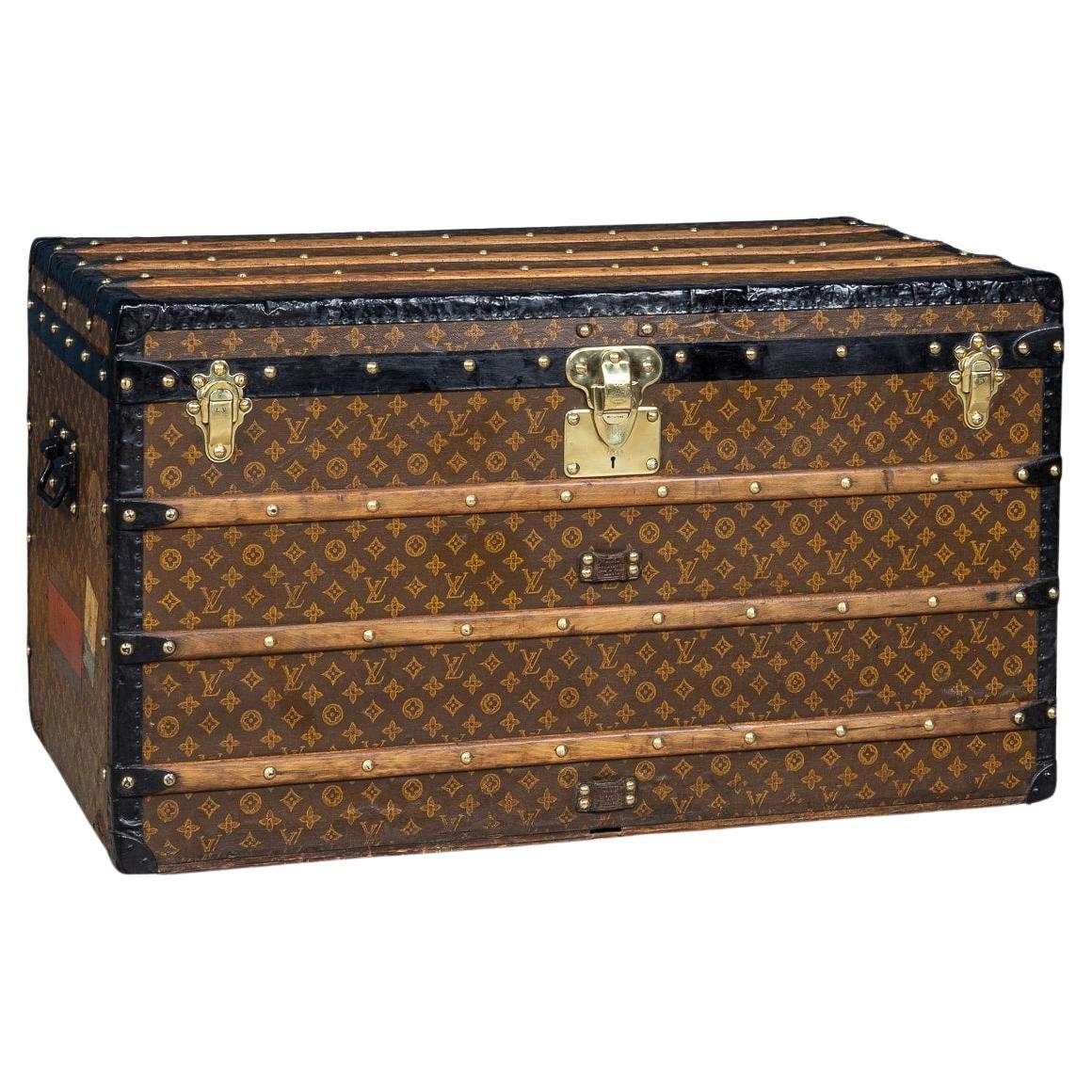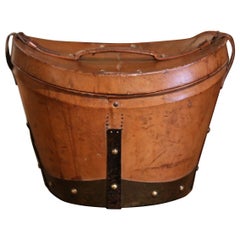
Early 20th Century French Stencil and Monogram Louis Vuitton Leather Hat Trunk
View Similar Items
Early 20th Century French Stencil and Monogram Louis Vuitton Leather Hat Trunk
About the Item
- Creator:Louis Vuitton (Manufacturer)
- Dimensions:Height: 21.5 in (54.61 cm)Width: 25 in (63.5 cm)Depth: 19 in (48.26 cm)
- Materials and Techniques:
- Place of Origin:
- Period:
- Date of Manufacture:circa 1926
- Condition:Wear consistent with age and use.
- Seller Location:Dallas, TX
- Reference Number:Seller: 222-4741stDibs: LU951229821182
Louis Vuitton
The story behind iconic luxury brand Louis Vuitton — best known for its esteemed handbags, crossbody bags, leather goods, ready-to-wear clothing and more — is one of craft and innovation in the worlds of fashion, jewelry and furniture.
The company’s modest origins can be traced back to when its founder, Louis Vuitton (1821–92), wishing to free himself from the conventional lifestyle in his provincial French city of Anchay as well as a difficult stepmother, left in the early 1830s to make a new life in Paris. The young Vuitton was 13 at the time and would need to travel on foot to get to the capital, which was hundreds of miles away. With stops along the way to make money so that he could forge ahead, the journey took a couple of years, but reward was close at hand.
When he arrived in Paris, Vuitton made a living with his hands. He toiled as a box maker and packer for more than a decade and built relationships with royals and members of the upper class while working for the empress of France, Eugenie de Montijo. In 1854, Vuitton launched his namesake company. The craftsman opened a humble workshop on rue Neuve des Capucines and advertised his services with a small poster that read: “Securely packs the most fragile objects. Specializing in packing fashions.”
Long before his brand would become known globally for its exemplary top-handle bags and stylish totes, Vuitton produced stackable and rectangular trunks. The most common trunks of the era were round, which weren’t ideal for toting and storing. In 1858, Vuitton debuted his lightweight, handcrafted canvas trunks, which were sturdy, rugged and equipped with convenient compartments. Travel’s popularity broadened in the late 19th century, and Vuitton’s trunks could easily be packed into train cars and ships — upright trunks meant hanging wardrobe storage that would allow his clients to transport their sophisticated garments without worry. Demand increased and the company grew. When Louis Vuitton died in 1892, control of the luxury house was passed onto his only son, Georges Vuitton.
In 1914, a Louis Vuitton store opened at 70 Champs-Élysées. The largest travel-goods store in the world at the time, it became the company’s flagship.
The Louis Vuitton brand embodies all the attributes of luxury, from the craftsmanship, exclusivity and relevance to heritage. It’s only appropriate that it boasts one of the most recognizable insignias — the imaginative interlocking of letters and fleurettes — in the fashion world. The famous LV monogram was first used in 1896 as part of an initiative by Georges to prevent counterfeiting of his coveted new line of travel trunks. It’s one of the earliest examples of fashion branding.
The LV monogram would soon appear on everything from bags and various fashion accessories to alligator-skin champagne cases, from stylish apparel and earrings to teddy bears and airplane models.
On 1stDibs, the unmistakable insignia can be found on both modern and vintage Louis Vuitton shoulder bags, suitcases, original 19th-century trunks, jackets and more.
- Early 20th Century French Napoleon III Brass Wire BirdcageLocated in Dallas, TXDecorate your home with this whimsical antique bird cage. Crafted in France, circa 1920, this cage made of brass, is cylindrical in shape and topped with a rounded dome embellished w...Category
Early 20th Century French Napoleon III Bird Cages
MaterialsBrass
- Early 20th Century French Painted Iron and Wire Aviary Birdcage on WheelsLocated in Dallas, TXAdd color and whimsical charm to your kitchen or breakfast room with this large antique aviary bird cage. Crafted in France circa 1920 and built in two ...Category
Early 20th Century French Art Deco Bird Cages
MaterialsWire, Iron
- Mid-19th Century French Oval Pigskin Leather Hat Box with Original Top HatLocated in Dallas, TXThis exquisite, antique pigskin box was crafted in Rouen France, circa 1870. This leather box features leather straps and handle embellished with decorativ...Category
Antique Mid-19th Century French Trunks and Luggage
MaterialsBrass
- Early 20th Century French Terrestrial Globe on Iron Base by J. Forest, ParisBy J. ForestLocated in Dallas, TXDecorate an office or a desk with this beautifully preserved antique terrestrial globe. Crafted in France, circa 1930, the terrestrial piece is mounted on a gilt painted cast iron tr...Category
Early 20th Century French Globes
MaterialsBrass, Iron
- Early 20th Century Chinese Lacquered Ebonized Six-Panel Decorative ScreenLocated in Dallas, TXDivide a room or decorate a living room wall with this elegant antique folding screen. Crafted in China circa 1920, the free standing screen stands on bracket feet dressed with brass...Category
Early 20th Century Chinese Chinese Export Screens and Room Dividers
MaterialsBrass
- Mid-19th Century French Oval Pigskin Leather Top Hat Box from ParisLocated in Dallas, TXThis exquisite, antique pigskin hat box was crafted in France, circa 1870. This leather high box features leather straps and handle embellished with decorative brass nail heads, and the inside is dressed with the original red velvet upholstery. The piece is in excellent condition and has a rich patinated brown leather finish. This hat box would make a unique addition to a travel, trunk or fashion accessory collection. A top hat (also called a high hat, a cylinder hat, or a topper), is a tall, flat-crowned hat for men traditionally associated with formal wear in Western dress codes, meaning white tie, morning dress, or frock coat. Traditionally made of black silk or sometimes grey, the top hat emerged in Western fashion by the end of 18th century. Although it declined by the time of the counterculture of the 1960s, it remains a formal fashion accessory. A collapsible variant of a top hat, developed in the 19th century, is known as an opera hat...Category
Antique Mid-19th Century French Trunks and Luggage
MaterialsBrass
- Antique 20th Century Louis Vuitton Hat Trunk In Monogram Canvas, France c.1910By Louis VuittonLocated in Royal Tunbridge Wells, KentAround the turn of the 19th and 20th century Louis Vuitton had established himself as a market leader in trunk making and needed to set his now famous brand apart from the imitators ...Category
Vintage 1910s French Other Trunks and Luggage
MaterialsBrass
- Antique 20th Century Louis Vuitton Hat Trunk In Monogram Canvas, Paris c.1900By Louis VuittonLocated in Royal Tunbridge Wells, KentA superb example of an early 20th century Louis Vuitton hat trunk in the world famous monogrammed LV canvas. Complete with all its interior trays, this unusually sized trunk is in ve...Category
Antique Early 1900s French Other Trunks and Luggage
MaterialsBrass
- 20th Century Louis Vuitton Trunk In Monogram Canvas, France, c.1900By Louis VuittonLocated in Royal Tunbridge Wells, KentGorgeous and most importantly complete, this early 20th century Louis Vuitton trunk was the must have item of any elite traveller. Covered in the world famous LV monogrammed canvas, ...Category
20th Century French Trunks and Luggage
MaterialsBrass
- 20th Century Louis Vuitton Trunk In Monogram Canvas, France c.1910By Louis VuittonLocated in Royal Tunbridge Wells, KentAn exquisite and complete Louis Vuitton trunk from the early part of the 20th century. An absolutely essential item for elite travellers of its time the trunk is adorned in the iconi...Category
20th Century French Other Trunks and Luggage
MaterialsBrass
- 20th Century Louis Vuitton Trunk In Monogram Canvas, France c.1930By Louis VuittonLocated in Royal Tunbridge Wells, KentAn exquisite and complete Louis Vuitton trunk from the early part of the 20th century. An absolutely essential item for elite travellers of its time the trunk is adorned in the iconic LV monogrammed canvas, accented by lozine trim and brass fittings. This trunk stood as the epitome of luxury over 100 years ago, boasting an unparalleled level of sophistication and elegance, it remains a timeless masterpiece that transcends eras. The captivating allure of the Louis Vuitton trunk transforms it into more than a mere luggage accessory; it becomes a focal point for any room. With its impressive dimensions, it is perfectly suited as a striking coffee table, side table, or even as a standalone centrepiece, seamlessly integrating into any interior, whether modern or traditional. An extraordinary piece that not only pays homage to the past but also serves as a statement of unparalleled luxury in the present. A brief history about Louis Vuitton trunks: Louis Vuitton was born in 1821 to a farmer and milliner and came from a long-established working-class family in eastern France. Vuitton grew up understanding the effects of perseverance and a strong work ethic from watching his family. At the age of 16, he made the decision to walk 292 miles from his hometown to Paris to try and make a new life for himself. When he arrived the city was in the midst of industrialization with current modes of transportation evolving quickly allowing for longer journeys. With this came the need for sturdy travel pieces. Vuitton was taken as an apprentice for a successful box maker and packer named Monsieur Marechal. He learned to craft durable containers and how to pack them properly – a well-respected profession at the time.In 1854, years after he had mastered his craft and became well respected for it, Vuitton ventured out on his own to open a shop on Rue Neuve des Capucines. It was here that he began to establish himself as a luggage maker. Then, in 1858, Vuitton designed the first Louis Vuitton steamer trunk. At the time trunks had rounded tops to allow for water to run off but this did not allow for convenient stowage. Vuitton introduced a flat, yet waterproof, trunk that was easily stackable. The first of his trunks were outfitted with a grey canvas referred to as Trianon – it wouldn’t be until several decades later that the signature monogram would be introduced. With a burgeoning business, Vuitton moved his family and workplace to Asniere, where he employed twenty workers to craft his trunks. By 1900 he would have 100 employees, and in 1914 the company would more than double in size. After years of success, Vuitton began to experiment with the design of his luggage by introducing a new striped canvas pattern (1876) and later the still well-known Damier print (1888). The hand-painted patterns were developed to prevent counterfeits. Even in the late 1800s, Louis Vuitton was enough of a status symbol to warrant counterfeiting. In 1886, his son George invented and patented an ingenious locking system that made it impossible to pick the lock of their trunks. This lock is still used today. 1892 would prove to be a time of mourning for the family as Louis Vuitton passed...Category
20th Century French Other Trunks and Luggage
MaterialsBrass
- 20th Century Louis Vuitton Trunk, France c.1910By Louis VuittonLocated in Royal Tunbridge Wells, KentAn exquisite and complete Louis Vuitton trunk from the early part of the 20th century. An absolutely essential item for elite travellers of its time the trunk is adorned in the iconic LV monogrammed canvas, accented by lozine trim and brass fittings. This trunk stood as the epitome of luxury over 100 years ago, boasting an unparalleled level of sophistication and elegance, it remains a timeless masterpiece that transcends eras. The captivating allure of the Louis Vuitton trunk transforms it into more than a mere luggage accessory; it becomes a focal point for any room. With its impressive dimensions, it is perfectly suited as a striking coffee table, side table, or even as a standalone centrepiece, seamlessly integrating into any interior, whether modern or traditional. An extraordinary piece that not only pays homage to the past but also serves as a statement of unparalleled luxury in the present. A brief history about Louis Vuitton trunks: Louis Vuitton was born in 1821 to a farmer and milliner and came from a long-established working-class family in eastern France. Vuitton grew up understanding the effects of perseverance and a strong work ethic from watching his family. At the age of 16, he made the decision to walk 292 miles from his hometown to Paris to try and make a new life for himself. When he arrived the city was in the midst of industrialization with current modes of transportation evolving quickly allowing for longer journeys. With this came the need for sturdy travel pieces. Vuitton was taken as an apprentice for a successful box maker and packer named Monsieur Marechal. He learned to craft durable containers and how to pack them properly – a well-respected profession at the time.In 1854, years after he had mastered his craft and became well respected for it, Vuitton ventured out on his own to open a shop on Rue Neuve des Capucines. It was here that he began to establish himself as a luggage maker. Then, in 1858, Vuitton designed the first Louis Vuitton steamer trunk. At the time trunks had rounded tops to allow for water to run off but this did not allow for convenient stowage. Vuitton introduced a flat, yet waterproof, trunk that was easily stackable. The first of his trunks were outfitted with a grey canvas referred to as Trianon – it wouldn’t be until several decades later that the signature monogram would be introduced. With a burgeoning business, Vuitton moved his family and workplace to Asniere, where he employed twenty workers to craft his trunks. By 1900 he would have 100 employees, and in 1914 the company would more than double in size. After years of success, Vuitton began to experiment with the design of his luggage by introducing a new striped canvas pattern (1876) and later the still well-known Damier print (1888). The hand-painted patterns were developed to prevent counterfeits. Even in the late 1800s, Louis Vuitton was enough of a status symbol to warrant counterfeiting. In 1886, his son George invented and patented an ingenious locking system that made it impossible to pick the lock of their trunks. This lock is still used today. 1892 would prove to be a time of mourning for the family as Louis Vuitton passed...Category
20th Century French Other Trunks and Luggage
MaterialsBrass
Recently Viewed
View AllRead More
How to Spot a Fake Louis Vuitton
What are the telltale signs that you're holding a real Louis Vuitton and not a knockoff? We spoke with expert Diane D’Amato to find out. Of course, you don't have to worry about fakes on 1stDibs, where every seller is highly vetted.
Inside Louis Vuitton’s Most Popular Handbag Collaborations
The venerable brand has earned accolades (and gained new fans) for partnerships that meld fashion with art.




